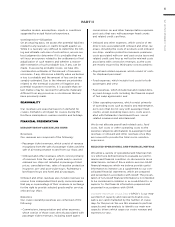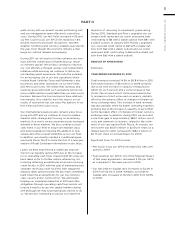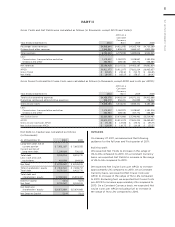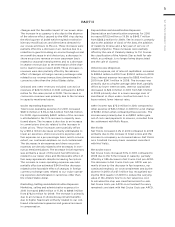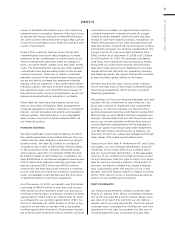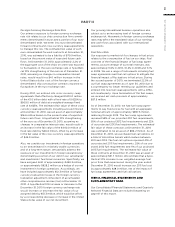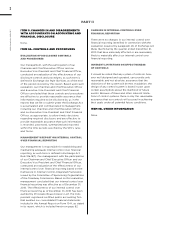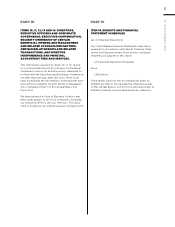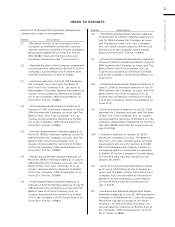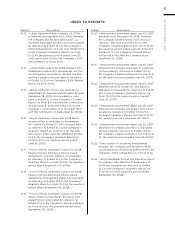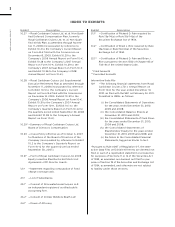Royal Caribbean Cruise Lines 2010 Annual Report Download - page 54
Download and view the complete annual report
Please find page 54 of the 2010 Royal Caribbean Cruise Lines annual report below. You can navigate through the pages in the report by either clicking on the pages listed below, or by using the keyword search tool below to find specific information within the annual report.
PART II
ROYAL CARIBBEAN CRUISES LTD. 51
review of available information, we do not believe an
indemnification is probable. However, if the lessor loses
its dispute and we are required to indemnify the lessor,
we cannot at this time predict the impact that such an
occurrence would have on our financial condition and
results of operations.
Some of the contracts that we enter into include
indemnification provisions that obligate us to make
payments to the counterparty if certain events occur.
These contingencies generally relate to changes in
taxes, increased lender capital costs and other similar
costs. The indemnification clauses are often standard
contractual terms and are entered into in the normal
course of business. There are no stated or notional
amounts included in the indemnification clauses and
we are not able to estimate the maximum potential
amount of future payments, if any, under these indem-
nification clauses. We have not been required to make
any payments under such indemnification clauses in
the past and, under current circumstances, we do not
believe an indemnification obligation is probable.
Other than the items described above, we are not
party to any other off-balance sheet arrangements,
including guarantee contracts, retained or contingent
interest, certain derivative instruments and variable
interest entities, that either have, or are reasonably
likely to have, a current or future material effect on
our financial position.
FUNDING SOURCES
We have significant contractual obligations of which
the capital expenditures associated with our ship pur-
chases and our debt maturities represent our largest
funding needs. We have $2.5 billion in contractual
obligations due in 2011 of which $725.1 million relates
to the acquisition of the Celebrity Silhouette along
with progress payments on Celebrity Reflection and
$1.2 billion relates to debt maturities. In addition, we
have $10.8 billion in contractual obligations due beyond
2011 of which debt maturities and ship purchase obli-
gations represent $7.9 billion and $703.6 million,
respectively. We have historically relied on a combina-
tion of cash flows provided by operations, drawdowns
under our available credit facilities and the incurrence
of additional debt to fund these obligations.
As of December 31, 2010, our liquidity was $1.6 billion
consisting of $419.9 million in cash and cash equiva-
lents and $1.2 billion available under our unsecured
revolving credit facilities. In addition, we had a working
capital deficit of $2.4 billion as of December 31, 2010
as compared to our working capital deficit of $1.7 bil-
lion as of December 31, 2009. Similar to others in our
industry, we are able to operate with a substantial
working capital deficit because (1) passenger receipts
are primarily paid in advance with a relatively low-level
of accounts receivable, (2) rapid turnover results in
a limited investment in inventories and (3) voyage-
related accounts payable usually become due after
receipt of cash from related bookings. In addition, we
finance the purchase of our ships through long-term
debt instruments of which the current portion of these
instruments increases our working capital deficit. The
current portion of long-term debt increased from
$756.2 million as of December 31, 2009 to $1.2 billion
as of December 31, 2010. We generate substantial
cash flows from operations and our business model,
along with our unsecured revolving credit facilities,
have historically allowed us to maintain this working
capital deficit and still meet our operating, investing
and financing needs. We expect that we will continue
to have working capital deficits in the future.
We have two Solstice-class vessels under construc-
tion in Germany both of which have committed bank
financing arrangements which include sovereign
financing guarantees.
We continue our focus on ensuring adequate cash and
liquidity. We are committed to improving our cost
focus and continue to implement cost containment
initiatives. To improve liquidity, we entered into a
second unsecured revolving credit facility during 2010
that provides us up to $525.0 million in available bor-
rowings. We anticipate that our cash flows from oper-
ations, our current available credit facilities and our
current financing arrangements will be adequate to
meet our capital expenditures and debt repayments
over the next twelve-month period. In addition, we
may elect to fund our contractual obligations through
other means if favorable opportunities arise.
If any person other than A. Wilhelmsen AS. and Cruise
Associates, our two principal shareholders, acquires
ownership of more than 30% of our common stock
and our two principal shareholders, in the aggregate,
own less of our common stock than such person and
do not collectively have the right to elect, or to desig-
nate for election, at least a majority of the board of
directors, we may be obligated to prepay indebted-
ness outstanding under the majority of our credit
facilities, which we may be unable to replace on similar
terms. If this were to occur, it would have an adverse
impact on our liquidity and operations.
DEBT COVENANTS
Our financing agreements contain covenants that
require us, among other things, to maintain minimum
net worth of at least $5.4 billion, a fixed charge cover-
age ratio of at least 1.25x and limit our net debt-to-
capital ratio to no more than 62.5%. The fixed charge
coverage ratio is calculated by dividing net cash from
operations for the past four quarters by the sum of
dividend payments plus scheduled principal debt


